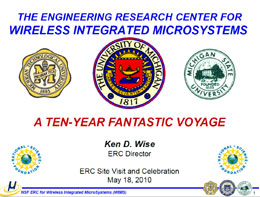WIMS and CUOS among 60 Years of Sensational Research by NSF
The WIMS has impacted health care, environmental monitoring, the national infrastructure while CUOS specializes in ultrafast lasers.

 Enlarge
Enlarge
Two NSF-funded research centers, the Center for Wireless Integrated Microsystems and the Center for Ultrafast Optical Science, achieved technological advances that have been recognized in the recent National Science Foundation publication, NSF Sensational 60.
The Center for Wireless Integrated Microsystems (WIMS) was recognized under the category, Centers of Knowledge. “Centers have proven to be powerful tools in solving current problems and training young researchers to solve the problems of the future. One indicator of the importance of these centers to the American science and engineering enterprise is the number of breakthroughs and discoveries that have resulted from research conducted at the ERCs [Engineering Research Centers] and STCs [Science and Technology Centers].” [pg. 22 of the publication]

 Enlarge
Enlarge
The WIMS Center recently completed its tenth and final year as an ERC, and will become an Institute. It has impacted health care, environmental monitoring, the national infrastructure and other areas, and it has spawned 11 startup companies.
A few of the major achievements that were supported by the center include: an active cardiovascular stent, an intraocular pressure sensor, cochlear implants, neural interfaces for the treatment of major diseases such as epilepsy and Parkinson’s, and an environmental and infrastructure monitoring microsystem. See the slide show, A Ten-Year Fantastic Voyage, for a complete summary of the center’s accomplishments.

 Enlarge
Enlarge
The Center for Ultrafast Optical Science (CUOS) began as an NSF Science and Technology Center in 1990, and in 2001 became an independent Center serving the entire campus community. Its specialty is ultrafast lasers – and it is home to the laser named Hercules, which holds the world record for on-target laser intensity. Ultrafast lasers enable research in fields ranging from optical communications, to high speed electronics and optoelectronics, quantum structures, micromachining, as well as biomedical applications.

 Enlarge
Enlarge
High speed femtosecond lasers enable eye surgery, and led to the celebrated technique of Lasik surgery, another of the Spectacular 60 innovations supported by NSF [see pg. 44 of the report]. The road to Lasik surgery began in a CUOS lab, where, ironically, a graduate student made a safety error when testing one of the ultrafast lasers. He received a very clean cut in his eye that was discovered and no-doubt ultimately admired by the attending physician, Dr. Ron Kurtz of the Kellogg Eye Center.
Intrigued that a laser could perform an incision much cleaner than the existing method of a scalpel, Dr. Kurtz later formed the Ultrafast Laser Medical Laboratory at CUOS with Prof. Gérard Mourou, Director of CUOS at the time, and in collaboration with Dr. Paul Lichter, chair of Ophthalmology. Tibor Juhasz, a research scientist with CUOS, and Dr. Kurtz founded IntraLase in 1997 to pursue laser eye surgery. Four years later, LASIK surgery was offered to the general public for vision correction.
“We are honored to have been mentioned even in a small way in this publication that highlights just a portion of the truly remarkable research enabled through the support of the National Science Foundation,” stated Khalil Najafi, Schlumberger Professor of Engineering and Chair of Electrical and Computer Engineering. “CUOS and WIMS reflect the very best in multidisciplinary research, and I look forward to witnessing the continued technological advances that will come out of these Centers, as well as by all of our faculty, and the promise this holds to benefit society in critical ways.”
Additional Information:
NSF Sensational 60 – Publication
URecord Article (June 1, 2010)
WWJ 950 (May 31, 2010)
Center for Wireless Integrated Microsystems
WIMS Celebrates 10 Years, and
Looks to the Future
Center for Ultrafast Optical Science
The story of IntraLase and Lasik Surgery
 MENU
MENU